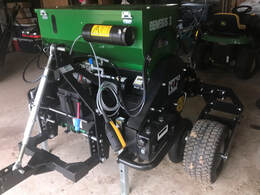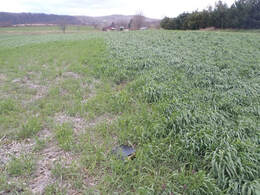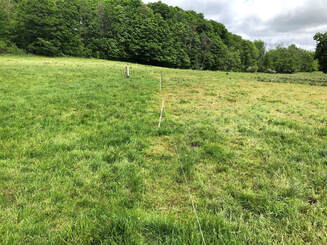CONSERVATION CORNER
A weekly blog for all things conservation
 By: Kevin Brown, Ag Resource Specialist, BCCD You haven’t? Then you just don’t know what kind of soil you are dealing with, do you? This is really a neat little experiment to see just how good your soil really is. How healthy is it? I have written a number of articles about soil health, as you may well know, and this is one way to determine how good your soil is.
0 Comments
 Farming really is the good life. Anyone that has had a hand in it knows this. It has taught me money management, time management, long days, hard work, respect for both humans and animals alike, and where things really come from; along with realities of life and death as animals are born or animals pass away as time marches on, to learning how to survive off the land if I really had to. There is no better place to raise a child. They come out as respectful, hard workers. Most bosses love to hire people that have come from a farm. An excerpt from a previous article by Amy Kneller, previous Farmland Preservation coordinator, BCCD
Open enrollment for Farmland Preservation in Bradford County is each January (now). This is the reason for this article to be printed now. If you are interested, please get ahold of us ASAP. Farmland Preservation requires municipalities, landowners, and funding. To be eligible for the county Farmland Preservation program, farms must: 1) be part of an Agricultural Security Area (ASA) 2) contain at least 50% class I through IV soils, as defined by USDA-NRCS. 3) contain at least 50% harvested cropland, pasture or grazing lands 4) contain at least 50 contiguous acres OR over 10 acres and utilized for a crop unique to the area or contiguous to a property that already has a permanent conservation easement. Ag Security Areas (ASAs) are created by local municipalities to preserve the viability of local farms. Participating farms are protected from some “nuisance” challenges and local ordinances that would unreasonably restrict farm structures or farm practices. The ASA designation does not restrict the use of the property by the landowner. They may develop, sell, or subdivide the property in any manner authorized by local regulations.  I have written many times about soil health- why we need it, why we should care, what it takes to get it, etc. I won’t bore you with too many of those details in this article, but one of the principles of soil health is “do not disturb the soil”. This is the reason that I talk about no till gardens, no till cropping practices, cover crops, and the list goes on. The soil is home to hundreds of thousands of organisms per teaspoon, if you have good soil health. If you are one that “needs” to plow/rototill/etc., you are essentially completely destroying those organisms’ homes. It is no different that a major hurricane coming through some ocean front town on the coast. All these beneficial organisms have built their homes in the open spaces in the soil. We need to leave them alone as much as possible for them to stay and do the good things that they do.  See, I know how to put in a title that will get your attention. Now that I have it, I will tell you that we may have funds that can help you out. No, we can’t help with any of the everyday things. We are the Conservation District. Our job revolves around clean water. Mine, in particular, has to do with the Ag sector. However, we do have people down here that specialize in stream issues and forestry and such. Streams, as most of you are aware, are a whole different topic and very hard to explain what we can and can’t do. I will leave that to someone else. We live in a very unique area with unique topography. It is complicated.  Kevin Brown, Ag Resource Specialist, BCCD So you have animals, or you want to get some. You may have 1-2 acres that you can put them on, or you may have 10 acres. To most people, when they look at that much land, they think “That is a lot of land and it will support however many animals I want to have”. Let’s be honest, 3-5 horses on one full acre of ground doesn’t look like much. Neither does 15 cows on a full 10 acres of land. So, you get the number of animals you want and start a farm. All is well. The animals have plenty enough land to roam on. They are comfortable and happy. And when you start supplementing them with hay, you don’t think anything about it. That is how it is supposed to be. Right? Well, no, not really. Not for you or the environment.  Small grain field (grass would be the same) with extra nutrients on the right and none on the left Small grain field (grass would be the same) with extra nutrients on the right and none on the left By: Kevin Brown, Ag Team Leader So, my first comment is “nothing can compete with well managed grass in the northeast”. If you manage and feed your grasses correctly, they will outcompete everything else. If you have weeds, it is because the grasses are not being managed as well as they can be. They are lacking a good cutting schedule or nutrients. Depending on the weed, cutting them on a timely basis will help a lot. Most weeds we deal with are annuals. They live one year. You cut hem before they go to seed then you have that many less weed seeds next year. Do that a few years in a row and there are “no” seeds left to germinate. Now, that does not work on perennials. They will be harder to deal with. Call me and we can discuss how to handle them. It will depend on the weed.  By: Kevin Brown, Ag Team Leader I was struggling for a good topic this week when I guy walked in and started asking me about reseeding a field. How to do it, what he should use, etc. I think there are still enough people out there making hay on a lot of Bradford County fields so I will hit that topic this week. First off, we need rain! For non-farmers, how could you ask for a better year? Warm, dry, just beautiful weather. For farmers and gardeners, not so much.  By: Miranda Neville, Agricultural Resource Specialist Looking at the farmers in my life, some were born in to a seventh generation legacy while others chose to be first generation farmers but they all have one specific thing in common. No matter how long they have been farming they will spend their lives building their operation to create a legacy all their own. If (emphasis on ‘IF’) the day comes that they decide to retire or step back from farming, they want to be sure whoever takes the reigns will love and appreciate it just as they do. Finding someone who will take pride in what they do and who shares a passion for agriculture and their land is a rarity. So how does someone who spent their life cultivating their hopes and dreams (not to mention their life savings) ensure their legacy will live on?  Kevin Brown, BCCD, Ag Team Leader So, it is that time of year again. Time to let the animals out to pasture. No more feeding them stored forages that you had to make. No more catering to their every whim. Now, they can be let out and go take care of themselves. Well, at least for a short period of time. We like to say that we are “pasturing” our animals, but are we really? Yes, there are some that are, and do a really good job of it. However, opening the gate and letting them roam free on the same pasture for the next 6-7 months is not pasturing. That is an exercise lot. Yea, there may be some grass growing there originally, but unless you have an expansive pasture, that goes away fast. And even if you have a big enough lot that you don’t have to feed them any stored forages, you really aren’t doing the best thing for any of the resources you have. I will try to give you some information on some of the things going on with this style of “pasturing” that you may not know. It could make you a lot more money. |
AuthorsVarious staff at the Bradford County Conservation District Archives
April 2024
Categories
All
|
